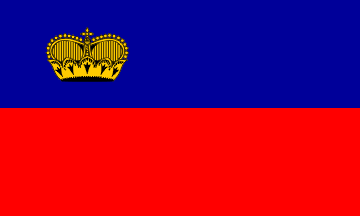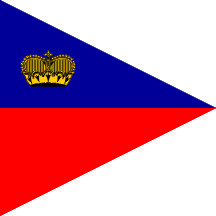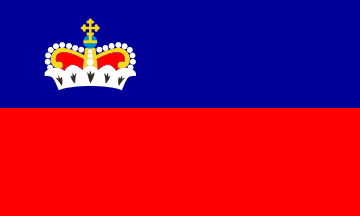
Last modified: 2007-06-09 by antónio martins
Keywords: liechtenstein | principality | vertical | error | government flag | princely | coat of arms: inescutcheon | bonnet | crown (golden) | crown (colored) | variant | doubt | aubergine |
Links: FOTW homepage |
search |
disclaimer and copyright |
write us |
mirrors
 3:5
3:5 
On 23 January 1719, Charles VI made a principality of the
county of Vaduz (now Unterland) and
the seigniory of Schellenberg (now
Oberland), which had been united since 1434. The first prince
was Anton-Florian of Liechtenstein. The castle of Liechtenstein
is located in Möding, in Lower-Austria.
After the dissolution of the Holy German
Empire in 1806, the principality became sovereign, joined the
Rhine Confederation (1807-1814) and later the
Germanic Confederation (1815-1866). A
customs union treaty was signed with Austria
in 1852 and denounced in 1918 following the breakdown of the
Austro-Hungarian Empire. In 1866, the
Prag peace between Austria and Prussia
confirmed the independence of Liechtenstein, which definitively
disbanded its army. The Constitution of 5 October 1921 replaced
the absolute monarchy by a constitutional one. Diplomatic,
customs, economic and postal union treaties were signed with
Switzerland between 1919 and 1923.
Liechtenstein joined Council of Europe
in 1978, United Nations Organization in
1990, European Free Trade Association
in September 1991, and European Economic Area in December 1992.
Ivan Sache, 01 Mar 2001, translating and adapting Roger Baert
in [bat00]
Blue over red bicolour with golden princely bonnet in canton.
Željko Heimer, 12 May 2002
The German text of the 1982 law prescribes four kinds of flag:
In the official flag book of Liechstenstein
[kra82], the shade
of blue is the same for all flags, and the
prince and
government flags also 3:5,
just like the national flag.
Pascal Vagnat, 12 Oct 1999
In 1937, the head of government Joseph
Hoop presented officially the new flag and
gave a symbolic interpretation of its colours: «Blue is the colour of
a radiant sky, red the colour of the embers in the fireplace during evening
gatherings; gold of the crown shows that our people, our country and
our princely House are united in heart and spirit.»
Ivan Sache, 01 Mar 2001, translating and adapting
Roger Baert in [bat00]
 by Željko Heimer, 12 May 2002
by Željko Heimer, 12 May 2002
The German text of the 1982 law prescribes four kinds of flag:
Liechstenstein has a 4:1 banner, two vertical stripes blue
and red, and the crown appears on it, in the canton, and is still
“horizontally”.
Pascal Vagnat, 13 Apr 1999
The size of the bonnet is given in Neubecker’s Flaggenbuch
[neu92] as 40×50 cm, and the distance
from top to the top of the bonnet is 55 cm. Of course, the bonnet’s
vertical axis is centered on the blue stripe.
Željko Heimer, 12 May 2002


Last weekend, I have visited to Flag Museum
managed by László Balogh. I have noticed that flag of Liechtentestein
there (received from Liechtenstein!) is different, because of the princely
crown.
Horváth Zoltán, 25 Nov 2002
Every Liechtenstein flag I’ve ever seen has the all-yellow
crown.
Nathan Lamm, 25 Nov 2002
The official website of the Princely House of Liechtenstein uses the
version with the all-gold crown. See
llvweb.liechtenstein.li/lisite/html/liechtenstein/index.jsp?sync=true&useIOId=true&L=en_EN&D=A0000049.
Ned Smith, 26 Nov 2002
According TV sports news, fans supporting the Team Liechtenstein
durign the last two football (soccer) matches as hosts (vs England and vs
Slovakia) waved national flags with crown colored instead of gold. Possibly
a variant? Note also that the national team jersey, either red or blue or
yellow, bears the crown colored also.
Manuel Gabino, 13 Oct 2003
In Neubecker’s Flaggenbuch 1939
[neu92],
the details of the bonnet are somewhat different than those in the Album
2000 [pay00]: the design is simpler —
without the perls and hatching of “inner” part.
Željko Heimer, 12 May 2002
The bonnet was slightly modified on 4 June
1957 and modernized on 30 June 1982.
Ivan Sache, 01 Mar 2001, translating and adapting Roger Baert
in [bat00]
Interestingly, Baert [bat00] calls the
crown “bonnet de prince” and not couronne.
Ivan Sache, 01 Mar 2001
.gif)
Translated from www.liechtenstein.li/lisite/html/liechtenstein/index.jsp?treeId=ZALFAK_de_DE&topicId=0.9&sync=true:
The “virgin eagle” (Jungfrauadler) appeared first in the Nuremberg coat of arms and initially depicted an eagle with a crowned king’s head. Through the centuries and particularly from the 15 century onwards it adopted more and more female-like features.
- Shield quartered: first, or an eagle sable, crowned and armed gold, [langued gules], charged with a trefoiled crescent and a cross formy all argent (Silesia);
- second, fessy of eight or and sable, a crancelin in bend vert (Kuenringe);
- third, per pale argent and gules (Troppau);
- fourth, or a virgin eagle [approx. a crowned harpy] sable, crowned and armed or, headed argent (East Friesland or Rietberg).
- On a point azure, a [hunting] horn or (Jaegerndorf).
- Inescutcheon: per fess or and gules (Princely House of Liechtenstein).
- Mantle: prince’s mantle purpure [it looks gules though] doubled ermine,
- crowned with a prince’s crown [rimmed in ermine].
The greater State arms are also the dynastic arms of the princely House.
They have remained unchanged since 1623 and were confirmed as greater
State arms by the law of 4 June 1957.
The lesser arms were established by the law of 4 June 1957. Per fess or
and gules (i.e. the escutcheon of the greater arms), topped with the
bonnet de prince.
Ivan Sache, 01 Mar 2001, translating and adapting Roger Baert
in [bat00]
Liechstenstein also has the lesser coat of arms, consisting of yellow
over red shield topped with princely bonnet in proper colours.
Željko Heimer, 12 May 2002
2004!.gif)
A very nice person in the Liechtenstein Government Press Office gave me
this
reference. As has been pointed out: this is not a flag replacement
but in terms of symbology it might be of interest.
Marten Gallagher, 05 Jul 2004
Everything about the new “corporate identity” of Liechtenstein is here to read (my translation):
The new image of Liechtenstein doesn’t replace the official state coat of arms or state flag. It completes them. It was created, in order to give to Liechtenstein a larger perception and recognizing effect. An appearance, which addresses to humans personally and develops relations, something that most official state symbols cannot obtain.That might be the aubergine (
Anything below this line was not added by the editor of this page.